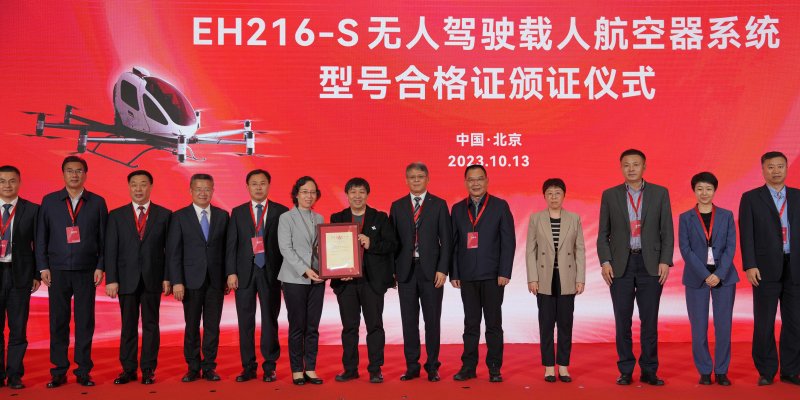EHang Holdings Limited announced that the EH216-S, its self-developed passenger-carrying unmanned aerial vehicle (UAV) system, has obtained the type certificate (TC) officially issued by the Civil Aviation Administration of China (CAAC).
This demonstrates that the EH216-S’s model design fully complies with CAAC’s safety standards and airworthiness requirements, and that the EH216-S is qualified for conducting passenger-carrying UAV commercial operations. As the world’s first TC for unmanned electric vertical take-off and landing aircraft (eVTOL), the EH216-S TC not only sets a benchmark for the airworthiness certification of innovative eVTOLs in China and overseas, but also serves as an epoch-making milestone for commercial UAM operations.
The EH216-S TC awarding ceremony was held at the CAMIC International Convention Center in Beijing on October 13, during which CAAC issued the EH216-S TC to EHang.
Since CAAC formally accepted EHang’s EH216-S TC application in January 2021, the EHang team worked closely with CAAC and its expert team towards validating and verifying the aircraft’s innovative cutting-edge technologies. After more than 1,000 days and nights of persistent efforts, they overcame all kinds of difficulties and challenges to successfully complete all type certification objectives, proving that EHang is fully capable of independently designing, developing, and manufacturing mature unmanned eVTOL products.
The EH216-S stands as a pioneering technological and product innovation with significant differences from conventional aircraft in key areas including technical architecture, configuration, performance, functionality, operational mode and flight environment. For the EH216-S type certification, CAAC and EHang upheld conventional century-old aviation principles alongside an innovation-centric approach, which involved formulating specific certification basis and means of compliance tailored to the EH216-S’s distinctive technical features, to conduct the type certification work.
In the realm of airworthiness certification standards, CAAC assembled leading experts from local authorities, aviation institutions and research organizations, and formally published the Special Conditions for the EH216-S UAV System (Special Conditions) in February 2022. Amidst a global landscape where eVTOL aviation airworthiness regulations are still evolving, it is a pioneering initiative that China has formulated a rigorous and scientific regulatory framework of airworthiness certification for the EH216-S passenger-carrying UAV system. This represents the collective expertise of CAAC, EHang, and unmanned aviation professionals nationwide, and provides a robust foundation for more efficient and wide-scale airworthiness certification for aircraft of this kind in China and abroad.
During the validation process, the EH216-S underwent extensive laboratory, ground, and flight tests at professional aviation laboratories and test sites across multiple locations in China. These tests included but were not limited to main material performance, structural strength, flame resistance, crashworthiness, gas toxicity, environmental conditions of equipment and systems, software simulation, data links, ground control stations, overall system functionality, electromagnetic compatibility, flight performance and flight stability characteristics. The validation process scrutinized components, equipment, and the entire aircraft for prefabricated defects, faults and interferences during both laboratory experiments and flight trials.
With that, the safety, airworthiness, performance, functionality, usability and reliability of the EH216-S have been thoroughly and rigorously validated through over 500 specific test items, more than 40,000 test flights for adjustments, and formal conformity validation tests encompassing 65 major categories and over 450 individual test items. CAAC’s experience and expertise in conducting the EH216-S airworthiness certification provides a significant reference for the global aviation industry and plays a pivotal role in shaping regulations, standards, and norms for unmanned eVTOL airworthiness certification, serving as a crucial benchmark for the industry worldwide.

